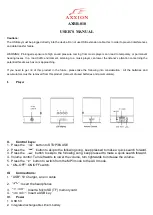
REV 41351-20120712
12
41351
ENGLISH
Connecting Electrical Loads
1 . Let the engine stabilize and warm up for a few
minutes after starting
2 . Plug in and turn on the desired 120/240 Volt AC
single phase, 60 Hz electrical loads .
– DO NOT connect 3-phase loads to the generator .
– DO NOT connect 50 Hz loads to the generator .
– DO NOT overload the generator .
Connecting a generator to your electric utility
company’s power lines or to another power source
may be against the law . In addition this action,
if done incorrectly, could damage your generator
and appliances and could cause serious injury or
even death to you or a utility worker who may be
working on nearby power lines . If you plan to run a
portable electric generator during an outage, please
notify your electric utility company immediately
and remember to plug your appliances directly
into the generator . Do not plug the generator into
any electric outlet in your home . Doing so could
create a connection to the utility company power
lines . You are responsible for ensuring that your
generator’s electricity does not feed back into the
electric utility power lines .
If the generator will be connected to a building
electrical system, consult your local utility company
or a qualified electrician . Connections must isolate
generator power from utility power and must comply
with all applicable laws and codes .
NOTE
OPERATION
Stopping the Engine
1 . Turn off and unplug all electrical loads . Never start
or stop the generator with electrical devices plugged
in or turned on .
2 . Let the generator run at no-load for several minutes
to stabilize internal temperatures of the engine and
generator .
3 . Turn the Fuel Valve to the “OFF” position .
4 . Let the engine run until fuel starvation has stopped
the engine . This usually takes a few minutes .
5 . Press the ignition switch to the “OFF” position .
Important: Always ensure that the Fuel Valve and the
Engine Switch are in the “OFF” position when the engine
is not in use .
If the engine will not be used for a period of two (2) weeks
or longer, please see the Storage section for proper engine
and fuel storage .
NOTE
















































